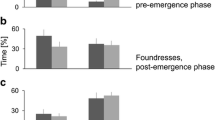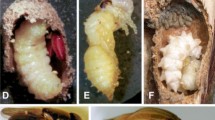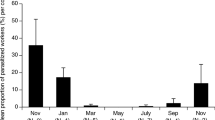Abstract
The productivity of social groups depends critically on effective regulation of work effort among group members. In social insect colonies, regulation of work may be decentralised or alternatively may be controlled by one or a few individuals (‘pacemakers’) within the colony. Social parasites, which usurp host colonies and replace the dominant as the principal reproductive, similarly depend on efficient regulation of work by hosts to rear parasite offspring, but few studies have explored the strategies used by parasites to achieve this. We compared the role of the social parasite Polistes semenowi in regulating host activity with that of the dominant individual on unparasitized nests of the host species, P. dominula. Dominant foundresses acted as pacemakers within unparasitized colonies, interacting frequently with colony members to initiate activity bursts and foraging trips, whereas parasites did not initiate more activity than the average colony member. Nonetheless, overall activity levels were similar in parasitized and unparasitized colonies, indicating that parasites may use other, indirect means to control the host activity. Colony activity did not change significantly following the removal of parasites or dominant host foundresses, perhaps because other individuals rapidly assumed the dominant position, or because of persistent indirect effects on colony activity. The role of P. semenowi in regulating the host activity differs strikingly from that reported for a second Polistes social parasite, P. atrimandibularis, suggesting that different Polistes social parasites may have fundamentally different social roles within host colonies, despite being closely phylogenetically related to one another.



Similar content being viewed by others
References
Almond EJ (2007) Interaction between the paper wasp Polistes dominula and its social parasite, Polistes semenowi. Dissertation, University College London
Anderson C, McShea DW (2001) Individual versus social complexity, with particular reference to ant colonies. Biol Rev 76:211–237
Bruschini C, Cervo R (2011) Venom volatiles of the paper wasp social parasite Polistes sulcifer elicit intra-colonial aggression on the nest of the host species Polistes dominulus. Insect Soc 58:383–390
Camazine S, Deneubourg JL, Franks NR, Sneyd J, Theraulaz G, Bonabeau E (2001) Self-organization in biological systems. Princeton University Press, Princeton
Cant MA, Field J (2001) Helping effort and future fitness in cooperative animal societies. Proc R Soc Lond B 268:1959–1964
Carpenter JM (1997) Phylogenetic relationships among European Polistes and the evolution of social parasitism (Hymenoptera: Vespidae: Polistinae). Mémoires du Muséum national d’histoire naturelle 173:135–161
Cervo R (2006) Polistes wasps and their social parasites: an overview. Ann Zool Fenn 43:531–549
Cervo R, Turillazzi S (1996) Host nest preference and nest choice in the cuckoo paper wasp Polistes sulcifer (Hymenoptera: Vespidae). J Insect Behav 9:297–306
Cervo R, Macinai V, Dechigi F, Turillazzi S (2004) Fast growth of immature brood in a social parasite wasp: a convergent evolution between avian and insect cuckoos. Am Nat 164:814–820
Choudhary M, Strassmann JE, Queller DC, Turillazzi S, Cervo R (1994) Social parasites in Polistine wasps are monophyletic: implications for speciation. Proc R Soc Lond B 257:31–35
Cini A, Bruschini C, Poggi L, Cervo R (2011) Fight or fool? Physical strength, instead of sensory deception, matters in host nest invasion by a wasp social parasite. Anim Behav 81:1139–1145
Cini A, Nieri R, Dapporto L, Monnin T, Cervo R (2014) Almost royal: incomplete suppression of host worker ovarian development by a social parasite wasp. Behav Ecol Sociobiol 68:467–475
Danforth BN, Cardinal S, Praz C, Almeida EAB, Michez D (2013) The impact of molecular data on our understanding of bee phylogeny and evolution. Ann Rev Entomol 58:57–78
De Souza AR, Prezoto F (2012) Regulation of worker activity in the social wasp Polistes versicolor. Insect Soc 59:193–199
Fucini S, Lorenzi MC (2004) Behavioural counter-adaptations to social parasites in Polistes biglumis, host of P. atrimandibularis (Hymenoptera, Vespidae). Insect Soc Life 5:27–29
Fucini S, Uboni A, Lorenzi MC (2014) Cuckoo wasps manipulate foraging and resting activities in their hosts. Behav Ecol Sociobiol 68:1753–1759
Gamboa GJ, Wacker TL, Scope JA, Cornell TJ, Shellman-Reeve JS (1990) The mechanism of queen regulation of foraging by workers in paper wasps (Polistes fuscatus, Hymenoptera, Vespidae). Ethology 85:335–343
Green JP, Field J (2011) Assessment between species: information gathering in usurpation contests between a paper wasp and its social parasite. Anim Behav 81:1263–1269
Green JP, Cant MA, Field J (2014) Using social parasitism to test reproductive skew models in a primitively eusocial wasp. Proc R Soc Lond B 281:20142016
Guillem RM, Drijfhout F, Martin SJ (2014) Chemical deception among ant social parasites. Curr Zool 60:62–75
Jeanne RL (2003) Social complexity in the Hymenoptera, with special attention to the wasps. In: Kikuchi T, Azuma N, Higashi S (eds) Genes, behaviors and evolution of social insects. Hokkaido University Press, Sapporo, pp 81–131
Jha S, Casey-Ford RG, Pedersen JS, Platt TG, Cervo R, Queller DC, Strassmann JE (2006) The queen is not a pacemaker in the small-colony wasps Polistes instabilis and P. dominulus. Anim Behav 71:1197–1203
Kilner RM, Langmore NE (2011) Cuckoos versus hosts in insects and birds: adaptations, counter-adaptations and outcomes. Biol Rev 86:836–852
Leadbeater E, Carruthers JM, Green JP, van Heusden J, Field J (2010) Unrelated helpers in a primitively eusocial wasp: is helping tailored towards direct fitness? PLoS ONE 5:e11997
Leadbeater E, Carruthers JM, Green JP, Rosser NS, Field J (2011) Nest inheritance is the missing source of direct fitness in a primitively eusocial insect. Science 333:874–876
Leadbeater E, Dapporto L, Turillazzi S, Field J (2014) Available kin recognition cues may explain why wasp behaviour reflects relatedness to nest mates. Behav Ecol 25:344–351
Lorenzi MC (2006) The result of an arms race: the chemical strategies of Polistes social parasites. Ann Zool Fenn 43:550–563
Lorenzi MC, Cervo R, Turillazzi S (1992) Effects of social parasitism of Polistes atrimandibularis on the colony cycle and brood production of Polistes biglumis bimaculatus (Hymenoptera, Vespidae). Ital J Zool 59:267–271
Lorenzi MC, Cervo R, Zacchi F, Turillazzi S, Bagnères AG (2004) Dynamics of chemical mimicry in the social parasite wasp Polistes semenowi (Hymenoptera: Vespidae). Parasitology 129:643–651
O’Donnell S (1998) Effects of experimental forager removals on division of labour in the primitively eusocial wasp Polistes instabilis (Hymenoptera: Vespidae). Behaviour 135:173–193
R Core Team (2014) R: A language and environment for statistical computing. R Foundation for Statistical Computing, Vienna, Austria. http://www.R-project.org/. Accessed Jan 2015
Reeve HK (1991) Polistes. In: Ross KG, Matthews RW (eds) The social biology of wasps. Cornell University Press, Ithaca, pp 99–148
Reeve HK, Gamboa GJ (1983) Colony activity integration in primitively eusocial wasps: the role of the queen (Polistes fuscatus, Hymenoptera: Vespidae). Behav Ecol Sociobiol 13:63–74
Reeve HK, Gamboa GJ (1987) Queen regulation of worker foraging in paper wasps: a social feedback control system (Polistes fuscatus, Hymenoptera: Vespidae). Behaviour 102:147–167
Richard F-J, Hunt JH (2013) Intracolony chemical communication in social insects. Insectes Soc 60:275–291
Shreeves G, Cant MA, Bolton A, Field J (2003) Insurance-based advantages for subordinate co-foundresses in a temperate paper wasp. Proc R Soc Lond B 270:1617–1622
Zacchi F, Cervo R, Turillazzi S, Moli FL, Mori A, Grasso DA (1996) How Polistes semenowi, obligate social parasite, invades the nest of its host, Polistes dominulus (Hymenoptera, Vespidae). Insect Soc Life 1:125–130
Zanette LRS, Field J (2008) Genetic relatedness in early associations of P. dominulus: from related to unrelated helpers. Mol Ecol 17:2590–2597
Acknowledgments
We thank Lorenzo Zanette for assistance in the field. This research was funded by Natural Environment Research Council Grant NE/E017894/1 to JF.
Author information
Authors and Affiliations
Corresponding author
Rights and permissions
About this article
Cite this article
Green, J.P., Almond, E.J., Williamson, J. et al. Regulation of host colony activity by the social parasite Polistes semenowi . Insect. Soc. 63, 385–393 (2016). https://doi.org/10.1007/s00040-016-0478-y
Received:
Revised:
Accepted:
Published:
Issue Date:
DOI: https://doi.org/10.1007/s00040-016-0478-y




